Shaibal S. Mitra, Chair, Doug Wilson, Secretary, Robert Emerson, Rachel Farrell, Paul L’Etoile, Peter Paton, and Scott Tsagarakis
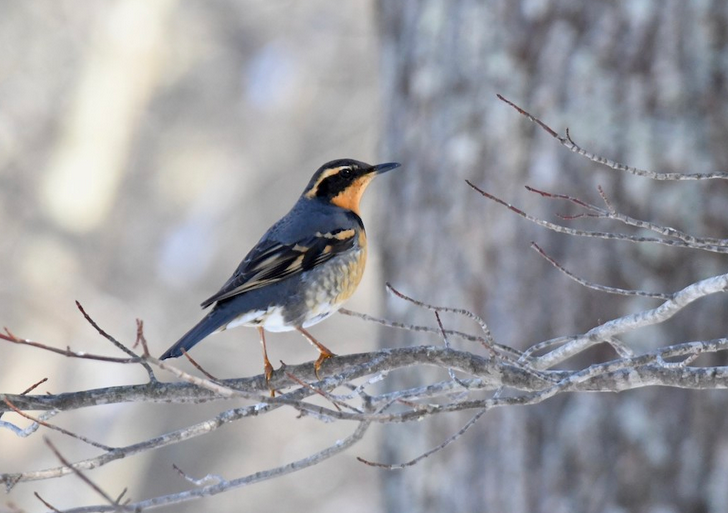
Varied Thrush. February 10, 2021. Exeter. Photograph by Sue Palmer.
This report presents the Rhode Island Avian Records Committee’s (RIARC’s) evaluation of 35 records, primarily from 2021, but with two from 2019 and an additional record from 2022 receiving expedited review. Highlights include no fewer than five first records for Rhode Island. Keenly anticipated owing to the species’s recent meteoric surge in occurrence in the Northeast, a Black-bellied Whistling-Duck was seen by many at Apponaug Cove, Warwick, but only on August 8, 2021. Even more obliging from the birder’s point of view was a juvenile Sharp-tailed Sandpiper that spent a week in the Galilee marshes during November 2021. Conversely, Rhode Island’s first Heermann’s Gull was only briefly seen in the state by observers tracking it from adjacent Massachusetts. Similarly, the Spotted Towhee found by Sue Palmer at Brenton Point, Newport, was seen only by its discoverer. Finally, the MacGillivray’s Warbler found by Dan Finizia and Sue Talbot at Blackstone Park, Providence, was seen and photographed by many during its one-day stay, November 7, 2022. Other highlights include Rhode Island’s fourth record of Varied Thrush and multiple Brown Boobies, which continue to increase in occurrence here and elsewhere in New England.
The publication this year of Richard L. Ferren’s Birds of Rhode Island: Seasonal Distribution and Ecological History marks a milestone in Rhode Island ornithology. Cited for decades as “Ferren, in litt.” or “Ferren, unpubl. ms.,” this uniquely detailed historical summary and compendium of records forms the core of what is known about birds in Rhode Island—for instance the “b” numbers described below, which for most rare species in Rhode Island constitute the great majority of all known records.
These records are grouped by species, with each species entry followed by four numbers in parentheses (a, b, c, d), defined as follows:
| a |
the number of records cited by Howe and Sturtevant (1899). |
| b |
the number of records accepted from 1900–2002. This number is derived principally from the Checklist of Rhode Island Birds (Rhode Island Ornithological Club 2002), which represents a synthesis of information from early drafts of Ferren (2024), Conway (1992), and records accepted by a pre-RIARC committee of reviewers for Field Notes of Rhode Island Birds through 2002 (Raithel 2001, 2002). The symbol “++” represents relatively frequent historical occurrence of the species, which could be replaced with a number pending ongoing research. |
| c |
the number of accepted records from 2003–2020, including those published in RIARC’s four previous reports (Mitra et al. 2010, 2021, 2022, 2023), plus additional records from that period published here. |
| d |
the number of accepted records from 2021—or more recently, in the case of first state records, published in the present report. |
The sum of a, b, c, and d represents the total number of verified records in Rhode Island through December 2021. For each record below, we list the RIARC report number; the vote of the Committee (accept–not accept); the number of individuals; the location; the date(s) of occurrence; and the observer(s), with the following codes:
| I |
initial finder |
| R |
reported details |
| P |
obtained photograph |
Black-bellied Whistling-Duck (Dendrocygna autumnalis) (0, 0, 0, 1)
2021–17 (6–0): One; Apponaug Cove, Warwick; August 8, 2021; multiple observers.
This species has greatly increased in the Northeast in recent years, so this first Rhode Island record was anticipated. As with all species popular in captivity, individual birds ought to be assessed for evidence of unnatural origins, but a pattern of regular occurrence during the warmer months is well established in the region.

Ross’s Geese. December 13, 2021. Weekapaug Breachway, Westerly. Photograph by Barbara Seith.
Ross’s Goose (Anser rossii) (0, 1, 8, 1)
2021–22 (6–0): Five; Weekapaug Breachway, Westerly; December 13, 2021; Barbara Seith (I, R, P).
This group of five Ross’s Geese sets a new high count for Rhode Island. As opposed to several prior occurrences, these birds were observed on just one day.
Pink-footed Goose (Anser brachyrhynchus) (0, 0, 5, 2)
2021–13 (6–0): One; Little Compton; Mike Kenton (P).
2021–14 (6–0): One; Manton Pond, Providence; February 2 to March 31, 2021; Jennifer Leitao (I), Bill Thompson (P).
This species has been reported almost annually in Rhode Island in recent years.
Tufted Duck (Aythya fuligula) (0, 10, 15, 0)
2021–23 (6–0): One; Trustom Pond National Wildlife Refuge, South Kingstown; January–March 2021.
Documentation through March 2021 extends the range of dates for this previously accepted individual (#2020-30).
Black-necked Stilt (Himantopus mexicanus) (0, 8, 2, 1)
2021–15 (5–1): One; Hundred Acre Cove, Barrington; May 18, 2021; Liam Corcoran (I, R).
Black-necked Stilts have been occurring with increasing frequency during May–June in the Northeast. The present record lacked photographs and was based on a relatively brief description—which nevertheless supported the identification of this highly distinctive species.
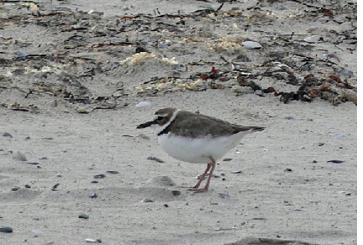
Wilson’s Plover. May 6, 2021. Napatree Point, Westerly. Photograph by Sue Palmer.
Wilson’s Plover (Charadrius wilsonia) (0, 10, 3, 1)
2021–12 (6–0): One; Napatree Point, Westerly; May 6–8, 2021; Jessica Bishop (R, P), Sue Palmer (R, P).
Found earlier in the day on May 6, this Wilson’s Plover was nicely documented by Jessica Bishop and Sue Palmer. This sighting represents at least the fifth record for Napatree Point, more than one-third of all Rhode Island records.
Sharp-tailed Sandpiper (Calidris acuminata) (0, 0, 0, 1)
2021–20 (6–0): One; Galilee, Narragansett; November 13–20, 2021; Sam Miller (I, R, P), Liam Corcoran (I, R, P).
The first record for Rhode Island, this stunning juvenile Sharp-tailed Sandpiper was seen by many observers during its week-long stay in the restored saltmarsh south of the Galilee Escape Road. It was often difficult to see and required patience. Its finders, Sam Miller and Liam Corcoran, are to be commended for carefully tracking, identifying, and documenting what was naturally, during initial brief views, an unfamiliar shorebird.
Long-billed Dowitcher (Limnodromus scolopaceus) (1, ++, 9, 1)
2019–24 (5–1): One, Atlantic Avenue, Westerly; December 9, 2019; Sue Palmer (I, R, P).
Acceptable records of Long-billed Dowitchers in Rhode Island have occurred less than annually this century owing to a paucity of preferred habitat in the state and the difficulty in distinguishing them from Short-billed Dowitchers. This record adds to the body of documentation for the species, which is more likely than Short-billed Dowitcher in late fall and early winter.
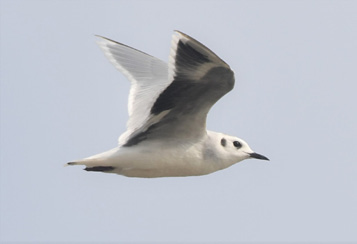
Little Gull. August 14, 2021. Ninigret Pond Mudflats, Charlestown. Photograph by Tim Metcalf.
Little Gull (Hydrocoloeus minutus) (0, ++, 5, 1)
2021–07 (6–0): One; Ninigret Pond Mudflats, Charlestown; August 14, 2021; Sue Palmer (I, P), Tim Metcalf (I, P), Sue Talbot (I).
This Little Gull showed a striking combination of immature and adult-like features, nearing completion of its molt from first-summer to second-winter plumage. Its co-occurrence with a fresh juvenile Bonaparte’s Gull and a Black Tern illustrates the dynamic potential for unusual larids around the ocean inlets in summer.
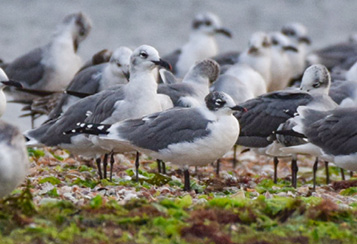
Franklin’s Gull. October 16, 2021. Conimicut Point, Warwick. Photograph by Patrick Felker.
Franklin’s Gull (Leucophaeus pipixcan) (0, 5, 5, 1)
2021–08 (6–0): One; Conimicut Point, Warwick; October 16, 2021; Patrick Felker (I, R, P).
Nicely documented by Patrick Felker, this adult Franklin’s Gull was associating with Laughing and Ring-billed gulls at Conimicut Point Park in Warwick. This is the first record for Kent County and the first Rhode Island record away from the outer coast.
Heermann’s Gull (Larus heermanni) (0, 0, 0, 1)
2021–16 (6–0): One; Sakonnet Point, Little Compton; May 27, 2021; Rachel Baum (R), Andrea Bean (R), Joseph Bourget (R, P), Dan Burton (R), Joel Eckerson (R, P), Jackson Frost (R), Jeffrey Offerman (R), Peter Trimble (R).
This first state record was found early in the afternoon of May 27, 2021, at Horseneck Beach, Bristol County, Massachusetts, by Nicole Kirkos and Tyler Tomassone. Other observers responded quickly and were able to track the bird westward to Richmond Pond, Acoaxet, and then to Sakonnet Point, Little Compton, Rhode Island. The photos obtained on the Rhode Island side of the border were not equal to those taken earlier in the day but clearly establish the individual and specific identity of this Heermann’s Gull.
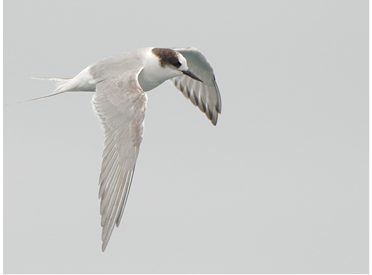
Arctic Tern. June 14, 2021. East Grounds, east of Block Island. Photograph by Paul L’Etoile.
Arctic Tern (Sterna paradisaea) (0, 13, 2, 1)
2021–09 (6–0): One; East Grounds (offshore); June 14, 2021; Paul L’Etoile (I, R, P).
The age, date, and maritime context of this beautifully photographed, first-summer Arctic Tern are typical for this species south and west of its breeding range, as documented in nearby Long Island, New York (Mitra 2009).
Sandwich Tern (Thalasseus sandvicensis) (0, 23, 7, 1)
2021–11 (6–0): One; Quonochontaug Breachway, Charlestown; June 8, 2021; Justin Lawson (I, R, P).
This species has occurred along Rhode Island’s ocean coast rarely but fairly regularly over many decades.
Leach’s Storm-Petrel (Hydrobates leucorhous) (3, ++, 2, 1)
2021–28 (6–0): One, Block Canyon; August 20, 2021; Doug Gochfeld (I, R).
The paucity of documented records of this species reflects the relative difficulty of accessing its deep-water habitat and of distinguishing it from similar storm-petrels. Although lacking photos, the description provided by the observer, an expert in the field of pelagic birding, supported the identification.
Brown Booby (Sula leucogaster) (0, 3, 1, 4)
2021–03 (6–0): One; Despair Island, Hope Island; September 11, 2021; Dave C.
2021–18 (6–0): One; Camp Cronin, Narragansett; September 11, 2021; Sam Miller, Liam Corcoran.
2021–19 (6–0): Two; Quonset Docks, North Kingstown; November 6 to December 10, 2021; Scott McConnell.
2021–21 (6–0): One; Conimicut Point Park, Warwick; November 25, 2021; Patrick Felker.
This series of well-documented records illustrates this species’s dramatic increase in occurrence in the Northeast.
White-faced Ibis (Plegadis chihi) (0, 2, 10, 2)
2021–26 (6–0): One; Jamestown; April 22–24, 2021; John Milhauskas (I, R, P).
2021–27 (6–0): One; Claddagh Farm, Tiverton; April 25, 2021; Joel Eckerson (I, R, P), Andy Eckerson (I, R), Matthew Eckerson (I, R, P).
This species has been reported about annually in recent years.
Golden Eagle (Aquila chrysaetos) (5, ++, 7, 1)
2019–05 (2–4): Providence; February 6, 2019.
2021–05 (6–0): One; Gardiner Pond, Middletown; November 7, 2021; Michael Dunn (R, P).
With only eight documented records in Rhode Island since 2002, Golden Eagle must be recognized as a rare species. Furthermore, some Golden Eagle plumages closely resemble those of Bald Eagles, which have been experiencing a dramatic increase in abundance. In the absence of convincing photos, the committee struggled to evaluate the description of the Providence bird, debating it through three rounds. Ultimately, although two committee members expressed support that the identification was likely correct, the record was not accepted. The bird at Gardiner Pond, Middletown, showed the relatively distinctive juvenile plumage and was nicely photographed by Mike Dunn.
Mississippi Kite (Ictinia mississippiensis) (0, 6, 13, 1)
2021–06 (6–0): One; Richmond; May 13–14, 2021; Tim Metcalf (I, R, P).
This record reflects the recent and ongoing expansion of this species in the Northeast.
Ash-throated Flycatcher (Myiarchus cinerascens) (0, 6, 6, 1)
2021–04 (6–0): One; Warwick; December 16–17, 2021; Marc Gagnon (I, R, P).
This species has been reported about annually in recent years.
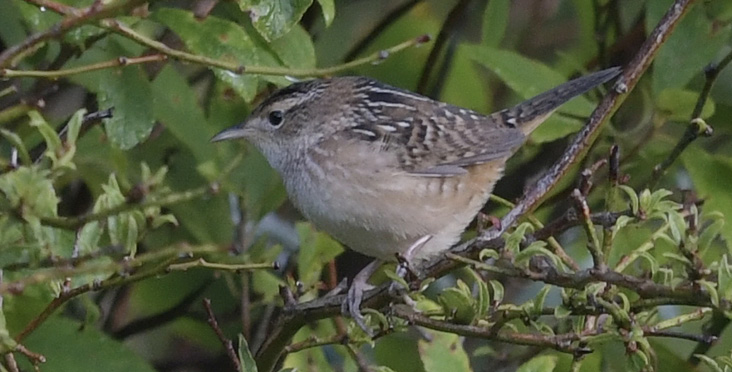
Sedge Wren. September 19, 2021. West Kingston, South Kingstown. Photograph by Dan Finizia.
Sedge Wren (Cistothorus stellaris) (1, ++, 3, 1)
2021–33 (6–0): One; West Kingston, South Kingstown; September 19, 2021; Dan Finizia (I, R, P), Sue Talbot (I, R, P).
Although greatly diminished in Rhode Island since the mid 20th century, Sedge Wrens still occur as rare, and difficult to detect, migrants.
Varied Thrush (Ixoreus naevius) (0, 2, 2, 1)
2021–25 (6–0): One; Exeter; February 10, 2021; Judith O’Brien (I), Sue Palmer (P).
This beautiful Varied Thrush, found by Judith O’Brien and documented by Sue Palmer, was the second in Rhode Island during winter 2020–2021 and just the fifth record overall.
Hoary Redpoll (Acanthis hornemanni) (0, 11, 3, 2)
2021–01 (6–0): One; Bold Point, East Providence; January 7–23, 2021; Ben Shamgochian (I, R, P).
2021–38 (5–1): One; Lonsdale Marsh, Lincoln/Cumberland; January 26–27, 2021; Carlos Pedro (I, R, P), Jan St. Jean (I, R), Tim Metcalf (R, P).
Distinguishing between Common and Hoary redpolls can be difficult, requiring a high level of documentation for acceptance.
Spotted Towhee (Pipilo maculatus) (0, 0, 0, 1)
2021–02 (6–0): One; Brenton Point, Newport; April 3, 2021; Sue Palmer (I, R, P).
Discovered by Sue Palmer but not seen thereafter, Rhode Island’s first Spotted Towhee showed ample spotting on the scapulars and wing coverts and a matte-black head, which are characters of the subspecies expected in the East, P. m. arcticus.
MacGillivray’s Warbler (Geothlypis tolmiei) (0, 0, 0, 1)
2022-01 (6–0): One; Blackstone Park, Providence; November 22, 2022; Dan Finizia (I, R, P), Sue Talbot (I, R, P).
A much anticipated first for Rhode Island, this MacGillivray’s Warbler was found by veteran birders Dan Finizia and Sue Talbot. Their superb photos and unambiguous description provide excellent documentation for this subtle identification. Furthermore, a number of other observers were able to see and photograph the bird during its brief stay.
Western Tanager (Piranga ludoviciana) (0, 7, 4, 1)
2021–35 (6–0): One; Avondale Preserve, Westerly; December 19–31, 2021; Glenn Williams et al. (I, R, P).
This Western Tanager was yet another rarity discovered by Glenn Williams et al. during the Napatree Christmas Bird Count.
Painted Bunting (Passerina ciris) (1, 8, 5, 1)
2021–24 (6–0): One; Misquamicut, Westerly; January 1, 2021; Erin Metcalf (R, P), Tim Metcalf (R, P).
2021–36 (6–0): One; Jamestown; December 22–31, 2021; homeowner (I), Sue Palmer (R, P).
Documentation for the Misquamicut bird extends the range of dates for the immature/female bird found by Glenn Williams and Andrew Dasinger in December 2020 (#2020-32). The adult male at a private residence in Jamestown adds another to the impressive number of records from the Narragansett Bay islands.
LITERATURE CITED
- Conway, R. A. 1992 Field-checklist of Rhode Island birds, 2nd ed. Rhode Island Ornithological Club Bulletin No. 1. Audubon Society of Rhode Island. 57 pp.
- Ferren, R. L. 2024. Birds of Rhode Island: Seasonal Distribution and Ecological History. Ithaca, New York: Cornell University Press. 559 pp.
- Howe, R. H. and E. Sturtevant. 1899. The Birds of Rhode Island. Privately printed. 111 pp.
- Mitra, S. S. 2009. Regular inshore occurrence of non-breeding Arctic Terns (Sterna paradisaea) during summer on Long Island, New York. Kingbird 59 (1):2–11.
- Mitra, S. S., D. Wilson, R. Emerson, R. Farrell, R. Ferren, C. Raithel, and S. Tsagarakis. 2010. First Report of the Rhode Island Avian Records Committee. Bird Observer 38 (5):275–283.
- Mitra, S. S., D. Wilson, R. Emerson, R. Farrell, R. Ferren, P. L’Etoile, P. Paton, C. Raithel, and S. Tsagarakis. 2021. Second Report of the Rhode Island Avian Records Committee. Bird Observer 49 (1):29–53.
- Mitra, S. S., D. Wilson, R. Emerson, R. Farrell, R. Ferren, P. L’Etoile, P. Paton, C. Raithel, and S. Tsagarakis. 2022. Third Report of the Rhode Island Avian Records Committee. Bird Observer 50 (4):251–263.
- Mitra, S. S., D. Wilson, R. Emerson, R. Farrell, R. Ferren, P. L’Etoile, P. Paton, C. Raithel, and S. Tsagarakis. 2023. Fourth Report of the Rhode Island Avian Records Committee. Bird Observer 51 (5):336–345.
- Raithel, C. J. 2001. 1999 Report of the Rhode Island Rare Bird Committee. Field Notes of Rhode Island Birds 382:19–21.
- Raithel, C. J. 2002. Report of the Rare Bird Committee. Field Notes of Rhode Island Birds 396:24–26.
- Rhode Island Ornithological Club. 2002. Checklist of Rhode Island Birds.
